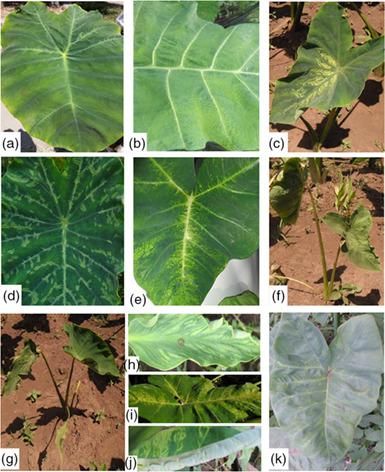当前位置:
X-MOL 学术
›
Ann. Appl. Biol.
›
论文详情
Our official English website, www.x-mol.net, welcomes your feedback! (Note: you will need to create a separate account there.)
Incidence of RNA viruses infecting taro and tannia in East Africa and molecular characterisation of dasheen mosaic virus isolates
Annals of Applied Biology ( IF 2.6 ) Pub Date : 2021-08-21 , DOI: 10.1111/aab.12725 Dawit B Kidanemariam 1, 2 , Amit C Sukal 1, 3 , Adane D Abraham 4 , Joyce N Njuguna 5 , Francesca Stomeo 5 , James L Dale 1 , Anthony P James 1, 6 , Robert M Harding 1
Annals of Applied Biology ( IF 2.6 ) Pub Date : 2021-08-21 , DOI: 10.1111/aab.12725 Dawit B Kidanemariam 1, 2 , Amit C Sukal 1, 3 , Adane D Abraham 4 , Joyce N Njuguna 5 , Francesca Stomeo 5 , James L Dale 1 , Anthony P James 1, 6 , Robert M Harding 1
Affiliation

|
Taro (Colocasia esculenta) and tannia (Xanthosoma sp.) plants growing in 25 districts across Ethiopia, Kenya, Tanzania and Uganda were surveyed for four RNA viruses. Leaf samples from 392 plants were tested for cucumber mosaic virus (CMV), dasheen mosaic virus (DsMV), taro vein chlorosis virus (TaVCV) and Colocasia bobone disease-associated virus (CBDaV) by RT-PCR. No samples tested positive for TaVCV or CBDaV, while CMV was only detected in three tannia samples with mosaic symptoms from Uganda. DsMV was detected in 40 samples, including 36 out of 171 from Ethiopia, one out of 94 from Uganda and three out of 41 from Tanzania, while none of the 86 samples from Kenya tested positive for any of the four viruses. The complete genomes of nine DsMV isolates from East Africa were cloned and sequenced. Phylogenetic analyses based on the amino acid sequence of the DsMV CP-coding region revealed two distinct clades. Isolates from Ethiopia were distributed in both clades, while samples from Uganda and Tanzania belong to different clades. Seven possible recombination events were identified from the analysis carried out on the available 15 full-length DsMV isolates. Nucleotide substitution ratio analysis revealed that all the DsMV genes are under strong negative selection pressure.
中文翻译:

东非感染芋头和丹宁的 RNA 病毒的发生率和 dasheen 花叶病毒分离株的分子特征
芋头 ( Colocasia esculenta ) 和 tannia ( Xanthosoma )sp.) 对生长在埃塞俄比亚、肯尼亚、坦桑尼亚和乌干达的 25 个地区的植物进行了四种 RNA 病毒的调查。通过 RT-PCR 对来自 392 株植物的叶片样本进行了黄瓜花叶病毒 (CMV)、大黄花叶病毒 (DsMV)、芋头脉萎黄病毒 (TaVCV) 和芋头骨病相关病毒 (CBDaV) 的检测。没有样本检测出 TaVCV 或 CBDaV 呈阳性,而 CMV 仅在来自乌干达的三个具有马赛克症状的 tannia 样本中检测到。在 40 份样本中检测到 DsMV,其中 36 份来自埃塞俄比亚,94 份来自乌干达,3 份来自坦桑尼亚,而来自肯尼亚的 86 份样本均未检测出四种病毒中的任何一种呈阳性。对来自东非的九个 DsMV 分离株的完整基因组进行了克隆和测序。基于 DsMV CP 编码区氨基酸序列的系统发育分析揭示了两个不同的进化枝。来自埃塞俄比亚的分离株分布在两个进化枝中,而来自乌干达和坦桑尼亚的样本则属于不同的进化枝。从对可用的 15 个全长 DsMV 分离株进行的分析中确定了七种可能的重组事件。核苷酸取代比分析表明,所有的 DsMV 基因都处于强烈的负选择压力下。
更新日期:2021-08-21
中文翻译:

东非感染芋头和丹宁的 RNA 病毒的发生率和 dasheen 花叶病毒分离株的分子特征
芋头 ( Colocasia esculenta ) 和 tannia ( Xanthosoma )sp.) 对生长在埃塞俄比亚、肯尼亚、坦桑尼亚和乌干达的 25 个地区的植物进行了四种 RNA 病毒的调查。通过 RT-PCR 对来自 392 株植物的叶片样本进行了黄瓜花叶病毒 (CMV)、大黄花叶病毒 (DsMV)、芋头脉萎黄病毒 (TaVCV) 和芋头骨病相关病毒 (CBDaV) 的检测。没有样本检测出 TaVCV 或 CBDaV 呈阳性,而 CMV 仅在来自乌干达的三个具有马赛克症状的 tannia 样本中检测到。在 40 份样本中检测到 DsMV,其中 36 份来自埃塞俄比亚,94 份来自乌干达,3 份来自坦桑尼亚,而来自肯尼亚的 86 份样本均未检测出四种病毒中的任何一种呈阳性。对来自东非的九个 DsMV 分离株的完整基因组进行了克隆和测序。基于 DsMV CP 编码区氨基酸序列的系统发育分析揭示了两个不同的进化枝。来自埃塞俄比亚的分离株分布在两个进化枝中,而来自乌干达和坦桑尼亚的样本则属于不同的进化枝。从对可用的 15 个全长 DsMV 分离株进行的分析中确定了七种可能的重组事件。核苷酸取代比分析表明,所有的 DsMV 基因都处于强烈的负选择压力下。



























 京公网安备 11010802027423号
京公网安备 11010802027423号